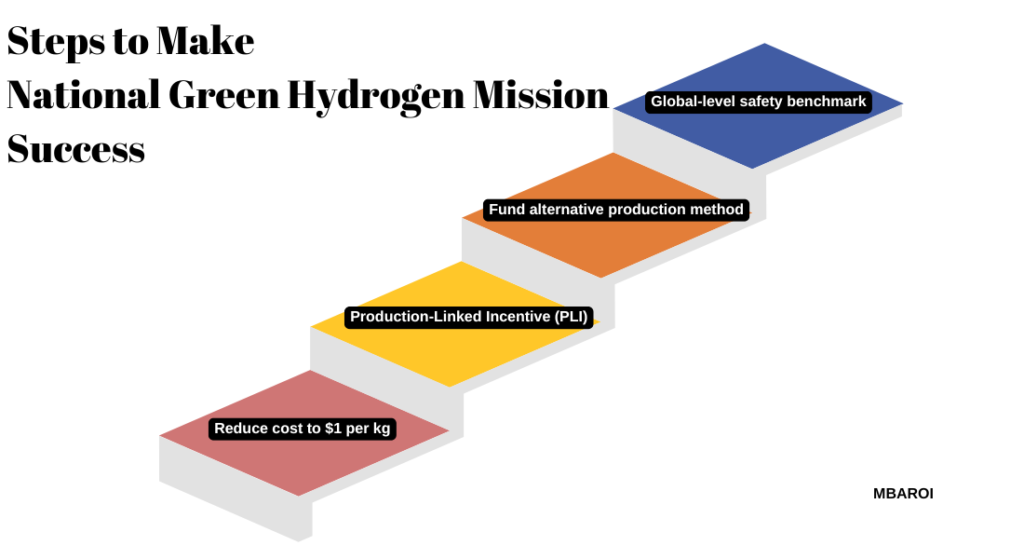National Green Hydrogen Mission -GD Topic

The National Green Hydrogen Mission GD Topic is among the most searched topics by MBA candidates for their group discussions. This mission is a revolutionary initiative by India to power its clean energy. The government in January 2023, announced this mission aiming to make the country a global center for producing and exporting green hydrogen. This plan will not just be about energy; it’ll reduce emissions, cut down on fossil fuel usage and import, and overall build a self-reliant India. Let’s talk about the National Green Hydrogen Mission GD Topic and its importance.
What is Green Hydrogen?
Green hydrogen is a type of hydrogen that’s produced by breaking water into hydrogen and oxygen. It’s done by using renewable energy resources like solar (sun), wind, or hydropower. Conventional hydrogen is made by fossil fuels but green hydrogen doesn't emit carbon like the prior. It’s best for decarbonizing industries, sustainable transportation, and clean power generation.
Why Green Hydrogen Matters?
India is highly reliant on coal for energy generation and that makes the energy sector one of the largest contributors to carbon emissions. We are using renewable energy sources such as solar and wind but these are unable to fulfill our demands. It’s believed that green hydrogen will bridge this gap. It’s a clean energy alternative for sectors like steel, cement, and fertilizers, which are kind of hard to decarbonize.
Here are some key benefits of green hydrogen:
- Clean Energy Transition: Green hydrogen reduces greenhouse gas emissions as it replaces fossil fuels with clean energy. With clean energy, we as a country can move towards cleaner and greener energy.
- Energy Independence: As per sources, cutting down on expensive fossil fuel imports, will save us up to ₹1 lakh crore annually by 2030. Not only green hydrogen is saving our planet but it also saves money. Awesome!
- Economic Growth: With the National Green Hydrogen Mission, India is expected to attract over ₹8 lakh crore in investments and generate around 6 lakh jobs by 2030. Having green hydrogen domestically will boost the country’s chances of economic growth.
- Technological Leadership: A successful Green Hydrogen Mission will position India as a leader in this green technology and our exports will rise. Foreign countries that don't have their own green hydrogen can import from us and that will increase our foreign exchange.
What is the National Green Hydrogen Mission-GD Topic?
This is India's government initiative to make India a global leader in producing and exporting Green Hydrogen. The Ministry of New and Renewable Energy is responsible for carrying out the National Green Hydrogen Mission. Finances for this project are outlaid for ₹19,744 crore, which will help in green hydrogen production, creating infrastructure, and supporting innovation.
Key objectives of the National Green Hydrogen Mission:
Production Target: To produce at least 5 Million Metric Tonnes (MMT) of green hydrogen annually by 2030.
Renewable Energy Addition: Another objective of this mission is to increase about 125 GW of renewable energy capacity. Fulfilling this objective means, we don't have to use much fossil fuel, and that in turn will save our environment.
Emission Reduction: Through this mission, our country aims to reduce nearly 50 MMT of CO2 annually by 2030. Less emissions will reduce ocean acidification, global warming, climate change, extreme weather and so much more.
Export Potential: Increasing export potential by positioning India as a global supplier of green hydrogen and its derivatives. We will have more monetary benefits and this will place us in the area of green leader.
Progress So Far
Since its launch, India has seen promising developments in green hydrogen:
- GAIL began blending or injecting grey hydrogen with the City Gas Station in Indore.
- NTPC started blending green hydrogen in the Piper natural gas (PNG) network in Kawas township in Surat.
- Jindal Stainless set up a hydrogen plant in Haryana for its manufacturing process which will cut 54,000 tonnes of CO2 emissions over 20 years.
- PSUs like NTPC and Oil India have introduced hydrogen-powered buses in Leh (5 hydrogen intra-city busses), Greater Noida, and other areas.
Challenges in the National Green Hydrogen Mission
Adopting green hydrogen as a source of energy does have several hurdles:
- Green hydrogen is around $4.10 to $7 per kg, which is more expensive than conventional hydrogen. This is one of the biggest challenges to this mission’s success.
- Issues of infrastructure are another challenge for a successful mission. Our country has limited hydrogen storage and transportation facilities right now.
- Water-stressed regions or lack of enough water will be a problem because electrolysis requires substantial water.
- Even though we have enough labour this particular industry requires skilled workers which too around 2.83 lakh. And we do have a gap in that sector.
- As global standards differ in terms of safety standards, so, India’s green hydrogen might not be accepted in many countries, creating barriers.
Steps To Make It A Success

In order to ensure the National Green Hydrogen Mission's success, we need to:
- Reduce cost by lowering production expense to $1 per kg by 2030 through manufacturing green hydrogen domestically and technological developments.
- Government should introduce schemes where they offer a Production-Linked Incentive (PLI) for other green metals like steel.
- Another way to go green and continue this National Green Hydrogen Mission is to initiate funding for alternative production methods like bio-hydrogen.
- GOI should establish global-level safety and carbon intensity benchmarks so, that countries from all around can import it without any doubt.
Conclusion
The above sections include everything one needs to know for the National Green Hydrogen Mission GD Topic. Also, this mission is very essential for our country as it’s a step towards clean energy, and a sustainable, self-reliant future. The usage of green hydrogen will reduce our carbon footprint, making us a global leader in clean technology and climate activism.
Also read other gd-topics- https://mbaroi.in/blog/sustainble-transport-gd-topic/ , https://mbaroi.in/blog/quick-commerce-vs-brick-and-mortar-store-the-battle-for-retail-supremacy/ , https://mbaroi.in/blog/india-vs-canada/ , https://mbaroi.in/blog/clicks-vs-bricks/